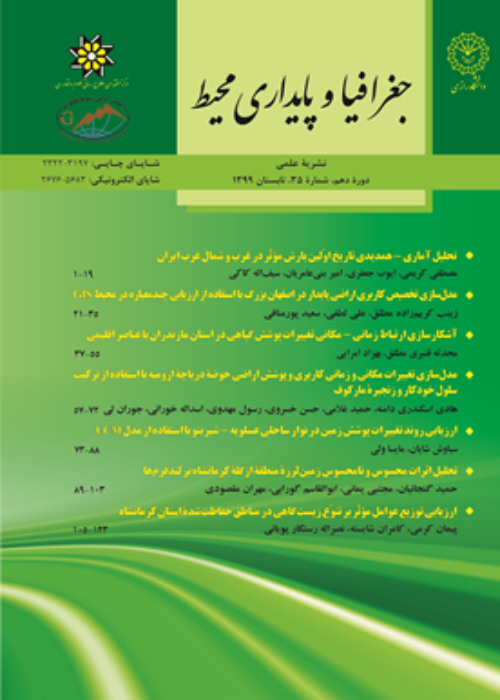The Role of the Tourists in the Karst Dissolution of the Secondary Shapes inside Caves (Case Study: Hamedan Alisadr Cave)
Author(s):
Abstract:
Introduction
As the most tourist attracting water cave in the country, Ali Sadr cave, located in Hamadan-Kabdtar Ahang, attracts thousands of internal and external tourists each year. It is considered as one of the most well-known caves in the world not only for its beauty but also for the numerous tourists it attracts. As a matter of fact more than 12000 people visit the cave during warm seasons, especially on holidays and weekends. Due to a lot of breathings, simultaneous entrance of tons of visitors into the cave makes the carbon dioxide concentration increase. Mixing with relatively high humidity which is saturated or near to be saturated, they make an acid environment inside the cave, especially in the roof including a lot of gaps and tracks. This phenomenon leads to corrosion and shelling out the secondary shapes available inside the cave namely stalactites, stalagmites and curtains. The present study aims at finding the role of visitors in corrosion and shelling out the secondary shapes in Ali Sadr Cave based on the Weight method. Therefore, the related data such as temperature, relative humidity and the cave carbon dioxide are gathered in order to simulate the cave climate in controlled laboratory conditions.Materials And Methods
In order to gather the related data to the role of visitors in climate elements variation and available Carbone dioxide inside the cave, the cave space is divided into two experimental region (visitors moving location) and controlled region (forbidden and uncleansed regions). Moreover, the tunnels, channels and lobbies are divided into three regions called low, middle, and high statures to increase the accuracy of data gathering and also considering different carbon dioxide concentrations in the channels and lobbies with different dimensions. The data were gathered by applying Co2 detector system type AZ77535 during a 30-day period in summer (at the time of maximum visitors entrance to the cave) and another 30-day period in fall (at the time of minimum visitors entrance to the cave). As the average data for Carbone dioxide, relative humidity, temperature and visitors portion in the data concentration increase and decrease were determined, the inside climate of the cave was simulated in the controlled laboratory condition. After precise determining of physical and chemical features, the disk stone samples, taken from three regions inside the cave, were tested in three glass chambers with different cycles during 60 days based on the numerical minimum, average and maximum of obtained carbon dioxide. The numbers were the result of a 60-day data gathering and the simulation of temperature and relative humidity in the experimental region inside the cave. After removing the samples from the glass chambers and determining exact physical properties, the solving and corrosion rates were obtained separately for natural and human influential factors based on weight method.Result and
Discussion
The findings reveal that the amount of the dissolution and lamination of the secondary shapes inside the Ali Sadr Cave is 0.078 G/cm3 annually that 0.060 G/cm3 of this amount equals to 77% of the total annual dissolution of the tourists portion. The results of the variance analysis of the taken carbon dioxide from the inside of the cave show that the concentration of carbon dioxide in the experimental areas in the summer simultaneously with the presence of the maximum number of visitors in different hours has significant differences. However, these dioxide concentration differences are not significant in the salons and corridors with different height. In other words, the size and height of the corridors are not regarded so important in the caves visited by a large number of tourists, for the concentration of carbon dioxide is the same through the cave. As a matter of fact, the dissolution and destruction of the cave walls and shapes happen in the same rate and amount.Conclusion
One of the most important phenomena which attracts thousands of tourists into the caves annually is the secondary interesting and fascinating shapes. The more gradual destruction of these wonderful shapes, the more decrease in the number of the tourists. In fact, the investment and advertisement which aims at increasing the number of the tourists not only can have a negative effect on the long run, but also can decrease the number of the visitors as a result of secondary shapes destruction in the cave. In the long run, this process will have significant effects on destroying the secondary Karst shapes inside the cave leading to decrease the stability of the tourism industry in this area. Keywords:
Language:
Persian
Published:
Geography and Sustainability of Environment, Volume:5 Issue: 16, 2015
Page:
1
https://magiran.com/p1563671
دانلود و مطالعه متن این مقاله با یکی از روشهای زیر امکان پذیر است:
اشتراک شخصی
با عضویت و پرداخت آنلاین حق اشتراک یکساله به مبلغ 1,390,000ريال میتوانید 70 عنوان مطلب دانلود کنید!
اشتراک سازمانی
به کتابخانه دانشگاه یا محل کار خود پیشنهاد کنید تا اشتراک سازمانی این پایگاه را برای دسترسی نامحدود همه کاربران به متن مطالب تهیه نمایند!
توجه!
- حق عضویت دریافتی صرف حمایت از نشریات عضو و نگهداری، تکمیل و توسعه مگیران میشود.
- پرداخت حق اشتراک و دانلود مقالات اجازه بازنشر آن در سایر رسانههای چاپی و دیجیتال را به کاربر نمیدهد.
In order to view content subscription is required
Personal subscription
Subscribe magiran.com for 70 € euros via PayPal and download 70 articles during a year.
Organization subscription
Please contact us to subscribe your university or library for unlimited access!


